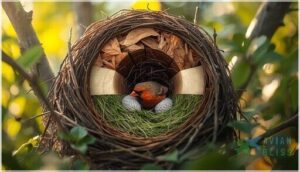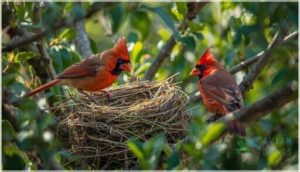This site is supported by our readers. We may earn a commission, at no cost to you, if you purchase through links.

You won’t find cardinals squeezing into birdhouses or claiming abandoned woodpecker holes. These vivid red birds build their own homes from scratch, tucking open cup nests into the dense tangles of shrubs and small trees.
The female cardinal weaves together twigs, bark strips, and grasses at heights between 1 and 15 feet, creating a shallow cradle that blends seamlessly with surrounding foliage. Her choice of location matters more than you might expect—nests hidden in vegetation with 75% density see success rates jump from 15% to over 70%.
Understanding where and how cardinals nest helps you recognize their preferred habitats and, if you’re hoping to welcome them to your yard, shows you exactly what these striking songbirds need to raise their young safely.
Table Of Contents
- Key Takeaways
- Where Do Cardinals Nest?
- What Do Cardinal Nests Look Like?
- How Do Cardinals Build Their Nests?
- When is Cardinal Nesting Season?
- What Trees and Shrubs Do Cardinals Use?
- How Do Cardinals Choose Nest Sites?
- Do Cardinals Reuse Their Nests?
- How Can You Attract Nesting Cardinals?
- What Threats Do Cardinal Nests Face?
- Where Are Cardinals Found in North America?
- Frequently Asked Questions (FAQs)
- What month do cardinals lay eggs?
- What kind of trees do cardinals nest in?
- What do cardinal nests look like?
- Do cardinals come back to the same nest every year?
- Do cardinals mate for life?
- Can cardinals take over other birds nests?
- Are cardinals known to be poisonous?
- How long do cardinal chicks stay in the nest?
- Do cardinals defend their nests aggressively?
- What do cardinals feed their baby birds?
- Conclusion
Key Takeaways
- Cardinals build fresh nests for each brood in dense shrubs 3-10 feet high, never reusing old nests or claiming birdhouses, because nest deterioration and predation risks make reuse dangerous.
- Nest success jumps from 15% to over 70% when vegetation density reaches 75%, which is why cardinals overwhelmingly choose thick foliage in dogwood, honeysuckle, and grapevines for concealment.
- The female constructs the entire nest over 3-9 days using a precise four-layer system—coarse twigs as foundation, leafy material, grapevine bark, and soft grasses—while the male focuses on territorial defense and feeding her.
- Cardinals typically raise two broods per season from March through September, with breeding activity peaking in May and each complete cycle taking 18-26 days from nest building through fledging.
Where Do Cardinals Nest?
Cardinals are remarkably adaptable regarding where they nest, but they do have clear preferences. You’ll find their nests in specific types of locations that offer the cover and safety they need to raise their young.
Let’s look at the typical spots where these bright red birds set up their nurseries.
Typical Nesting Locations
You’ll find cardinals nesting in small trees and shrubs, tucked into branch forks between 1 and 15 feet above ground. They avoid birdhouses entirely, preferring open cup nests hidden within dense foliage.
Nest site selection focuses on concealment—cardinals choose thickets at forest edges, overgrown hedgerows, and marshy tangles where the tree canopy and shrubbery provide protective cover at strategic nesting heights. Cardinals often build nests using nest building materials to create a safe environment.
Preferred Vegetation and Cover
Cardinals overwhelmingly choose dense shrubbery and native woody plants for nesting—90% of nests sit within thick shrubs, vines, or low trees. You’ll spot them in dogwood, honeysuckle, hawthorn, and rose, which together account for over 60% of nest sites. Dense foliage with 75% vegetation density offers significant concealment. Native shrub species provide 2.5 times better predator protection than sparse cover.
They also need conspicuous perches for singing.
Nest Height Above Ground
Once you’ve found that dense shrubbery, you’ll notice nesting sites usually sit 3 to 10 feet off the ground. Most cardinal nest locations cluster below 6 meters—about 20 feet—with 85% positioned there. Here’s what shapes nest height:
- Predation influence: Nests above 6.6 feet see higher success rates
- Seasonal shifts: Late broods average 18% higher than early ones
- Urban elevation: City nests can reach 40 feet in landscaped areas
- Regional variations: Northern populations choose slightly elevated sites
What Do Cardinal Nests Look Like?
If you’ve ever spotted a cardinal darting into dense foliage, you might wonder what kind of home it’s building in there. Cardinal nests are surprisingly compact structures, carefully woven to cradle their eggs and keep them safe from the elements.
Here’s what to look for when identifying these distinctive nests.
Nest Size and Shape
You’ll notice cardinal nests are compact, measuring about 4 inches in diameter and 2 to 3 inches tall. The inner cup—where eggs rest—spans roughly 3 inches across with a shallow 1.5-inch depth. This cup-shaped design balances structural integrity with insulation factors, while the nest’s camouflage design helps it blend into dense foliage, protecting nestlings from predators.
| Feature | Measurement | Purpose |
|---|---|---|
| Overall Diameter | 4–5 inches | Accommodates mid-sized fledglings |
| Nest Height | 2–3 inches | Provides shape evolution stability |
| Inner Cup Diameter | ~3 inches | Holds 2–5 eggs securely |
| Cup Depth | ~1.5 inches | Optimizes insulation factors |
| Width-to-Height Ratio | 2:1 | Enhances camouflage design |
Cup Structure Details
The cupped nest structure reveals four precise layers that showcase the impressive Cardinal nest-building process. Coarse twigs form the base, topped by leafy material, then grapevine bark lining, and finally soft grasses for thermal regulation.
This layer composition ensures shape functionality through the construction process—the female rotates inside, pushing outward with her feet. Material selection creates both insulation and structural integrity for Cardinal nest characteristics.
Common Nesting Materials
You’ll find twigs dominating the nest—they comprise up to 55% of the structure’s total mass. Dead leaves and grapevine bark strips provide insulation, while grasses, stems, and pine needles form the soft inner lining.
Cardinals occasionally weave in animal fur, feathers, or even grass clippings. In urban areas, they’ll adapt by using string or yarn when natural nest-building materials become scarce.
How Do Cardinals Build Their Nests?
Building a cardinal nest is a deliberate process that unfolds over several days. The female takes the lead in construction, though the male plays a supporting role throughout.
Let’s walk through how these birds transform simple materials into a secure home for their young.
Step-by-Step Nest Construction
Cardinal nest construction follows a precise, three-stage sequence that you can observe if you’re patient. The female builds methodically, making sure each layer has a purpose:
- Foundation building: She gathers hardy twigs and stems, weaving them into a sturdy platform in branch forks
- Cup formation: Softening materials with her beak, she spins to mold the structure around her body
- Lining insulation: Fine rootlets, grass, and pine needles create a warm, snug interior
- Material criteria: She selects pliable, strong components that interlock securely
- Construction sequence: The entire nest building process takes 3 to 9 days from start to finish
Female and Male Cardinal Roles
Regarding building, the female northern cardinal takes the lead on nest construction and incubation duties—she’s the architect and caretaker. Her male counterpart focuses on territorial defense and courtship feeding, passing food beak-to-beak to strengthen their bond.
Once chicks hatch, both parents shift to shared feeding, with the male often continuing care while she starts a new nest—a division that boosts nest success.
Nest Lining Techniques
The nest interior reveals a masterpiece of layered construction you mightn’t expect. Through material interweaving, females weave bark selection and fur usage into an elaborate design that adapts locally.
- Fine rootlets and grasses form flexible inner layers, accounting for 35% of lining weight
- Animal fur appears in 27% of nests, boosting temperature by 2.1°C
- Grapevine bark strips under 3mm thick provide reinforcement
- Cardinals complete 18 circular passes, tamping nest building materials with their feet
When is Cardinal Nesting Season?
Cardinal nesting season isn’t just a single moment—it’s a months-long window that shifts with the warming temperatures. These birds begin their breeding efforts as early as late February in southern regions, with activity ramping up through spring and extending into late summer.
Understanding this timeline helps you recognize when cardinals are actively building nests and raising their young.
Timing of Nest Building
You’ll notice early nesting signs like territorial defense and courtship displays as soon as late winter. The cardinal nest-building process generally begins in late February or early March, depending on your region.
In Maryland, the nesting season spans March through August, with peak activity in April and May. Nest-building duration usually takes 3 to 10 days, shaped by ideal conditions and material availability. Egg-laying timing follows immediately after completion.
Duration of Breeding Season
After nest-building wraps up, the Cardinal breeding season extends from March through September—up to seven months in many regions. You’ll see peak activity in May, though southern populations may start in February while northern birds begin later. Temperature effects and regional variations shape this timeline.
Each brooding cycle lasts 18 to 26 days, allowing multiple nesting attempts when environmental influences and food availability support extended parental investment.
Number of Broods Per Year
Over the breeding season, you’ll commonly observe two broods per year, though Cardinals can produce one to four depending on nest success and conditions. Some pairs raise three broods when food is plentiful. Early failures prompt re-nesting attempts, boosting brood frequency.
Each clutch contains three to four eggs. The female incubates the next clutch while her mate feeds fledglings—a pattern that maximizes reproductive output across the nesting period.
What Trees and Shrubs Do Cardinals Use?
Cardinals aren’t picky about every tree in your yard, but they do have clear favorites regarding nesting. They look for specific characteristics—dense foliage, sturdy branching structure, and good cover from predators.
Let’s look at the trees, shrubs, and vines that cardinals prefer for building their nests.
Favorite Nesting Trees
You’ll find northern cardinals building nests in specific tree species that offer dense cover and protection. Their cardinal nesting habits favor trees with thick foliage where they can gather nesting materials safely.
Popular cardinal habitat trees include:
- Eastern Red Cedar – An evergreen offering year-round concealment
- American Holly – Dense branches create ideal nesting sites
- Flowering Dogwood – Branching structure accommodates cup-shaped nests
- Hawthorn – Thorny protection deters predators
- Mulberry – Provides both shelter and food sources
These native shrubs and trees attract cardinals by meeting their need for security and accessibility.
Preferred Shrubs and Vines
Beyond trees, you’ll attract cardinals with dense foliage shrubs like arrowwood viburnum, northern bayberry, and staghorn sumac. These native plants offer protective cover and berry-producing benefits. Cardinals also favor rose bushes and blackberry brambles for their thorny predator defense.
Vine types such as wild grape and Virginia creeper create excellent nesting habitat—their tangled growth provides the security cardinals need during breeding season.
Nest Placement in Plants
You’ll spot cardinal nests wedged into branch forks at 1 to 15 feet high, usually nestled in dense shrubs or vine tangles. Plant selection matters—look for thick foliage offering solid nest camouflage through leaf coverage.
Cardinals weave nest-building materials within dogwood, honeysuckle, and grapevines, choosing spots where tangled growth creates natural concealment. This strategic positioning balances predator protection with easy parental access to their cup-shaped homes.
How Do Cardinals Choose Nest Sites?
When cardinals scout for a nesting spot, they’re weighing several survival factors at once. Safety from predators tops the list, but access to resources matters just as much.
Here’s what drives their choice of location.
Importance of Dense Foliage
Dense foliage is your cardinal’s first line of defense. When you look for cardinal nesting locations, you’ll notice they choose thick shrubs and heavily foliated trees where nest concealment helps them dodge predators.
This habitat selection matters—nest success rates jump from 15% to over 70% when foliage density increases. Bird protection relies on dense shrubbery that blocks predators’ view and boosts predator avoidance naturally.
Dense foliage increases cardinal nest success from 15% to over 70% by blocking predators and providing natural protection
Proximity to Water Sources
Near streams and reliable water sources, you’ll find cardinals building nests more often. They concentrate within 150 meters of water for hydration needs and bathing—essential for feather health. Riparian nesting zones offer lush vegetation, supporting higher nesting success rates.
You can boost water accessibility by adding a birdbath with 2-3 inches of depth. Regional variations exist, but cardinal habitat and range consistently favor areas where providing water sources for cardinals is simple.
Strategies for Predator Avoidance
You’ve probably noticed cardinals favor thick cover—that’s predator protection in action. They select sites 3-10 feet high in dense shrubs, relying on nest camouflage techniques that blend twigs and bark with surrounding foliage.
- Alarm calls alert mates to threats instantly
- Aggressive defense drives off squirrels and jays
- Female camouflage reduces visibility during incubation
- Predator statistics show over 50% risk without concealment
Protecting cardinals from predators means planting native shrubs and keeping cats indoors.
Do Cardinals Reuse Their Nests?
Cardinals generally don’t reuse their nests from previous seasons. Each breeding cycle prompts the female to build a fresh nest, even if an old one sits undisturbed nearby. Understanding why they start from scratch—and what happens to abandoned nests—reveals important patterns in cardinal nesting behavior.
Nest Reuse Patterns
Cardinal nest reuse is exceptionally rare—less than 1% of the time. You’ll find they almost always build fresh nests for each brood, even within the same nesting spot. When reuse does happen, it’s usually late-season or by other species like Gray Catbirds claiming an abandoned cardinal nest.
| Reuse Factor | Cardinal Behavior | Impact on Success |
|---|---|---|
| Reuse Frequency | <1% occurrence | Near-zero pattern |
| Interspecific Use | Catbirds occasionally claim old nests | Opportunistic only |
| Predation Risks | Predators memorize locations | Higher failure rates |
| Spatial Patterns | New nests <50m from old | Strong site fidelity |
| Productivity Impact | Delayed laying, smaller clutches | Reduced nesting success |
Cardinal nesting habits reveal striking consistency. They maintain territory loyalty but construct entirely new nests, protecting against parasites and predators while optimizing breeding success in their chosen Nesting Habitats.
Reasons for Building New Nests
Why build from scratch when the old nest still stands? Because nest deterioration makes reuse dangerous—over 90% of cardinal nests collapse after one season. Predation pressure and brood parasitism force immediate relocation.
You’ll see them construct fresh structures for multiple broods, often shifting nesting spots by 50 meters. Habitat disturbance from weather or human activity triggers rebuilding within days.
Smart nesting site selection means starting fresh each time.
Impact of Predators and Parasites
Nest predation rates hit 85% in some regions—snakes alone take 26% of clutches. Cowbird parasitism affects nearly half of all nests, puncturing eggs and reducing hatching success. Blood parasites infect 67% of adults. These threats drive rapid renesting adaptations and constant site shifting.
Predator defense strategies like alarm calls help, but dense cover remains your best protection for attracting nesting cardinals. That’s why cardinals won’t return to compromised sites.
How Can You Attract Nesting Cardinals?
If you want cardinals to nest in your yard, you’ll need to create the right conditions. These birds look for specific features when they’re scouting out a place to raise their young.
Let’s look at three key ways you can make your property more appealing to nesting cardinals.
Providing Dense Shrubs and Trees
To create the ideal habitat for nesting cardinals, you’ll want to focus on dense shrubs and trees that offer at least 85% canopy cover. Honeysuckle, multiflora rose, hawthorn, and spruce work exceptionally well.
Plant them in clusters 3–10 feet tall to give cardinals the concealment they need. Dense vegetation provides nest protection while also regulating temperature during hot afternoons.
Supplying Nesting Materials
You can boost nesting success by offering natural fibers like twigs, grasses, and pine needles during late March through early July. Material safety matters—skip synthetic fibers and treated substances.
Place these nestbuilding materials in clean suet cages or loosely on shrubs within 15 feet of dense cover.
Cardinals using supplied nesting material show 22% higher nesting attempts and earlier nest initiation by 4–6 days.
Creating a Safe Yard Environment
Beyond supplying nesting materials, hazard removal and safe landscaping transform your backyard habitat into a bird-friendly nesting site. Keep outdoor pets away from dense shrubs where cardinals nest. Remove reflective surfaces that trigger territorial aggression.
Skip pesticides—they contaminate the habitat. Regular cleaning of feeders and water sources prevents disease.
Predator mitigation through smart placement creates a cardinal-friendly habitat, providing shelter and protection that keeps nesting pairs returning each season.
What Threats Do Cardinal Nests Face?
Cardinal nests face dangers from multiple sources, and understanding these threats helps you protect nesting pairs in your yard. Predators, weather events, and human activities all put eggs and nestlings at risk.
Let’s look at the main threats that cardinal parents must navigate during the breeding season.
Common Predators
Cardinal nests face relentless threats from avian predators like Cooper’s Hawks and Blue Jays, mammalian dangers including cats and raccoons, and reptilian predators such as rat snakes. Protecting cardinal nests means understanding these risks—nest success hovers around just 15% due to predation. Parasitic risks from cowbirds further compromise survival.
You’ll find nest camouflage techniques help, but even dense cover can’t guarantee safety.
Environmental Hazards
Beyond the natural predators you’ve just learned about, environmental threats pose serious risks to cardinal nests. Heavy rainfall increases nestling mortality by up to 25%, while heat waves in urban areas can raise death rates by 30%.
Pesticide exposure from contaminated nest materials reduces hatch rates by 60%.
Habitat fragmentation, noise pollution, and light pollution further compromise reproductive success, with climate impacts driving these challenges higher each year.
Human Disturbance
Although your presence may seem harmless, it can trigger nest abandonment rates up to ten times higher in urban areas compared to rural habitats. You’ll want to keep your distance to guarantee bird protection and maintain the nesting spot’s security.
Human activity affects cardinals through:
- Nest Site Selection – Birds in backyards flush at longer distances, increasing vulnerability to predators.
- Behavioral Adaptations – Urban nesting success drops when disturbance occurs during early breeding.
- Predation Patterns – Despite reduced predator pressure near trails, frequent visits still compromise reproductive impact.
Where Are Cardinals Found in North America?
Cardinals have carved out an impressive territory across North America, and knowing where they live can help you spot them in your own backyard. Their range stretches from southern Canada down through the eastern United States into Mexico and Central America.
Let’s look at where you’re most likely to find these vivid red birds and how they’ve adapted to different regions.
Geographic Range and Distribution
You’ll find northern cardinals across a vast territory spanning 5.8 million square kilometers, from southeastern Canada through the eastern and central United States into Mexico and Central America. Their range expansion over 200 years reflects striking urban adaptation and climate influence.
Today, roughly 110 million breeding adults maintain population stability, with the highest habitat density along forest edges, suburban areas, and backyards throughout the southeastern states.
Habitat Preferences by Region
Your region shapes where cardinals settle. Urban vs. Rural differences are striking: metropolitan forest edges support 1.7 times more breeding pairs than countryside habitats, thanks to denser shrubbery and backyard feeders.
Vegetation Preferences shift regionally—southeastern cardinals favor evergreens while Midwest populations use deciduous cover.
Climate Influence and Human Impact drive Regional Expansion northward, with suburban areas now hosting thriving populations where dense cardinal habitat meets milder winters.
Year-Round Residency Patterns
You’ll find cardinals defending the same territory year-round—no migration needed. Their winter survival hinges on habitat adaptation near reliable food sources and evergreen trees for shelter.
Population stability has remained strong even as range expansion pushes northward, largely thanks to human influence through backyard feeders.
Adults maintain site fidelity across seasons, showing impressive resilience through winter months in their established cardinal habitat.
Frequently Asked Questions (FAQs)
What month do cardinals lay eggs?
In the rhythm of spring’s arrival, northern cardinals begin their egg laying patterns as early as March, with breeding cycles extending through August.
You’ll notice nesting schedules vary by region—warmer southern areas may see egg incubation start in late February, while cooler northern zones delay until April or May.
What kind of trees do cardinals nest in?
You’ll often spot cardinal nests in dogwood, spruce, pine, and redcedar trees. They also favor hawthorn, holly, and elms.
Dense shrubs like honeysuckle and rose bushes offer perfect cover with thick branch density.
What do cardinal nests look like?
You’ll spot a cardinal nest by its compact, cupped nest shape—roughly 4–5 inches wide and 2–3 inches tall.
The nest architecture features coarse twigs outside, with softer grasses and bark lining the shallow inner cup for nest camouflage.
Do cardinals come back to the same nest every year?
Like turning a new leaf each spring, cardinals don’t return to the same nest. You’ll find they build fresh nests annually due to nest site fidelity focused on territory, not structures—annual rebuilding prevents parasite accumulation affecting nesting behavior.
Do cardinals mate for life?
Cardinals usually form pair bonds lasting one or more breeding seasons, though not universally lifelong. About 80% remain together year after year, while serial mating and extra-pair copulations occasionally occur within cardinal populations.
Can cardinals take over other birds nests?
You might worry about backyard bullies, but cardinals rarely seize other birds’ nests.
They’re focused on nest building materials and weaving their own cup-shaped homes, preferring territorial defense over nest competition or aggressive interspecies conflict.
Are cardinals known to be poisonous?
Northern Cardinals pose no toxicity risks to humans or pets. These birds aren’t poisonous and carry no endogenous toxins.
Bird poisoning concerns don’t apply here—cardinal safety is well-established through decades of scientific observation.
How long do cardinal chicks stay in the nest?
You’ll see chicks leave the nest between 7 and 13 days after hatching, usually around 9 or 10 days. Parents continue feeding these fledglings for another 25 to 56 days until they’re independent.
Do cardinals defend their nests aggressively?
You’ll often see a cardinal dive-bombing its own reflection—mistaking glass for a rival.
Yes, both sexes defend nests fiercely through alarm calls, mobbing, and direct strikes, deterring smaller predators despite high overall nest failure rates.
What do cardinals feed their baby birds?
You’ll notice feeding baby cardinals centers on insect dominance—caterpillars, beetles, and larvae form up to 98% of nestling diets initially, meeting critical protein requirements.
Both parents share feeding roles, adjusting seasonal diet composition as chicks grow.
Conclusion
Picture a pair of cardinals returning each spring to the forsythia beside your porch, weaving their nest into branches you planted years ago. That’s the reward for understanding where cardinals nest and creating habitat they trust.
Dense shrubs at the right height, nearby water, and protection from predators transform your yard into breeding territory. You’re not just attracting birds—you’re giving them the cover and safety they need to raise their offspring.














